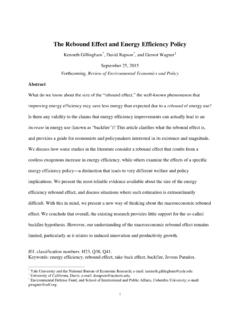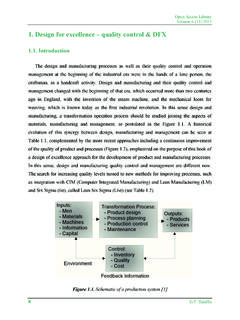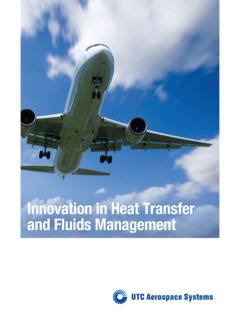Transcription of Hydrogen Internal Combustion Engine Vehicles: A …
1 Hydrogen Internal Combustion Engine Vehicles: A Prudent Intermediate Step or a Step in the Wrong Direction? Kenneth Gillingham Stanford University Department of Management Science & Engineering Global Climate and Energy Project Precourt Institute for Energy Efficiency Correspondence Address: Box 16336 Stanford, CA 94309 January 2007 Abstract Hydrogen Internal Combustion Engine (ICE) vehicles present much of the same promise as Hydrogen fuel cell vehicles (FCVs): reduced reliance on imported oil and reduced carbon dioxide emissions. Proponents envision Hydrogen ICE as a bridging technology from gasoline vehicles to Hydrogen FCVs. This paper examines the Hydrogen ICE technology, focusing on relevant aspects such as power, fuel economy, tank size, and the state of the technology.
2 An economic analysis is then performed to examine the potential implications of widespread adoption of Hydrogen ICE vehicles in the United States. The case for Hydrogen ICE depends most on key uncertainties in the evolution of vehicle and production technology, the cost of crude oil, and the valuation of carbon dioxide emission reductions. This analysis indicates that promoting Hydrogen ICE vehicles may be a sensible policy goal as a transition strategy to Hydrogen FCVs, but a more prudent policy would first promote gasoline-electric hybrids. Key Words: climate change, carbon dioxide, Hydrogen , technological change, Internal Combustion engines, fuel cells Contents 1. 2. Hydrogen in Internal Combustion Properties of Hydrogen .
3 4 Relevant Trade-offs ..5 3. Comparison of Vehicle Technologies ..6 4. Economics of a Hydrogen ICE Policy ..9 Scenarios of Vehicle Technology Adoption ..10 Fuel Use ..11 Carbon Dioxide Emissions ..11 Net Benefits ..13 5. References ..28 2 Hydrogen Internal Combustion Engine Vehicles: A Prudent Intermediate Step or a Step in the Wrong Direction? Kenneth Gillingham 1. Introduction At the center of on-going debates regarding energy security and global climate change issues lie the difficult issues inherent in the sizable light duty vehicle transportation sector. In contrast to most other sectors, in the light duty vehicle sector there are exceedingly few economically viable substitutes to the dominant energy source: gasoline.
4 Concerns over reliance on gasoline imports from unstable regions of the world, as well as the potential negative consequences of global climate change from gasoline s carbon dioxide emissions have motivated a vigorous policy debate on alternative pathways for the light duty vehicle transportation sector. The advent of hybrid gasoline-electric vehicles leaves considerable opportunity for improving the fuel economy of the light duty vehicle fleet without a switch to a radical new technology. However, several technologies hold promise for powering vehicles with lower-carbon feedstocks. In particular, both Hydrogen and electricity ( , in electric battery vehicles) can be used as energy carriers, in which energy can be generated from a variety of sources, including low-carbon sources, and stored as electricity or Hydrogen for eventual use in powering the vehicle.
5 For example, Hydrogen can be produced through feedstocks as varied as coal gasification, natural gas steam reforming, electrolysis using solar or wind generated electricity, or direct dissociation in nuclear power production. Powering a vehicle using one of these energy carriers produces little or no tail-pipe carbon dioxide emissions ( , the product of Hydrogen Combustion with oxygen is water). This opens the possibility of running much of the transportation sector on energy derived from low-carbon sources, alleviating one of the major stumbling blocks in the way of reducing carbon dioxide emissions and oil imports. The author would like to gratefully acknowledge very useful conversations with James Sweeney and Chris Edwards, of Stanford University, and Dan Sperling of UC-Davis.
6 Many thanks are also due to Amul Sathe of Stanford University for sharing his technical expertise. All errors are the full responsibility of the author. Kenneth Gillingham Hydrogen Internal Combustion Engines 3 In the 1990s, efforts to introduce battery-electric vehicles in California largely failed, mostly due to an extremely limited range. More recent efforts have shifted to promoting Hydrogen . Since 2003, President Bush s Hydrogen Fuel Initiative has received an appropriation of $150-250 million per year for Hydrogen R&D (DOE 2007). In California, Governor Arnold Schwarzenegger signed an Executive Order that plans for a Hydrogen Highways Network to develop a Hydrogen infrastructure in California (Schwarzenegger 2004).
7 In July 2005, California Senate Bill 76 was signed, providing $ million in initial funding to begin developing this infrastructure. These public policy actions underscore the importance many believe Hydrogen has in the future of the transportation system. But, there are many questions that remain unanswered concerning the economic feasibility and desirability of Hydrogen in light duty vehicles. Moreover, Hydrogen can be used in both fuel cell vehicles (FCVs) and Hydrogen Internal Combustion Engine (ICE) vehicles, and both technologies are currently being developed (Ford 2007). Most discussion and analysis of Hydrogen has centered on the fledgling fuel cell technology due to sizeable potential fuel efficiency gains ( , NRC 2004).
8 The advocates of Hydrogen ICE vehicles see them as a crucial intermediate step to push the Hydrogen production infrastructure forward, so it is ready for when FCVs are commercialized. However, there has been relatively little analysis of the merits of promoting Hydrogen ICE vehicles as a transition step. This paper aims to fill this gap through an analysis of the technical details and the economics of Hydrogen ICE vehicles. Emphasis is placed on a comparison of Hydrogen ICE light duty vehicles to the most prominent competing technologies of gasoline hybrids and Hydrogen FCVs. The paper is organized as follows. Section 2 provides a brief overview of the history and technical specification of Hydrogen ICE vehicles, Section 3 is a comparison of different vehicle technologies, Section 4 presents a scenario analysis of the economics of Hydrogen ICEs, and Section 5 concludes.
9 2. Hydrogen in Internal Combustion Engines Hydrogen -burning Internal Combustion engines trace their roots back to some of the very earliest developments in Internal Combustion Engine development. Initially, gaseous fuels like Hydrogen were preferred to liquid fuels like gasoline because they were considered safer to work Kenneth Gillingham Hydrogen Internal Combustion Engines 4 with, due to the low pressures used for the gaseous fuels and the quick dissipation of the gases in the event of a leak. In 1807 Issac de Rivas built the first Hydrogen Internal Combustion Engine , and although the design had serious flaws, it was a more than 50 years ahead of the development of gasoline Internal Combustion engines (Taylor 1985).
10 Technological advances in gasoline engines, such as the development of the carburetor (which allowed air and gasoline to be consistently mixed), eventually led to other fuels being largely passed over in favor of gasoline. Until recently, Hydrogen has been relegated to niche uses, such as in experimental vehicles or in the space program. Properties of Hydrogen There are several important characteristics of Hydrogen that greatly influence the technological development of Hydrogen ICE and FCVs. Wide Range of Flammability. Compared to nearly all other fuels, Hydrogen has a wide flammability range (4-74% versus volume in air for gasoline). This first leads to obvious concerns over the safe handling of Hydrogen .














